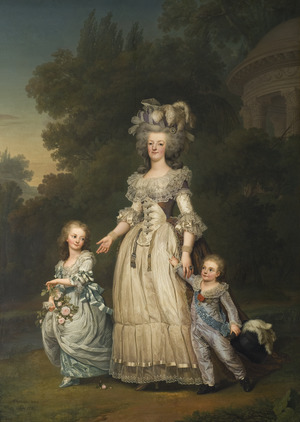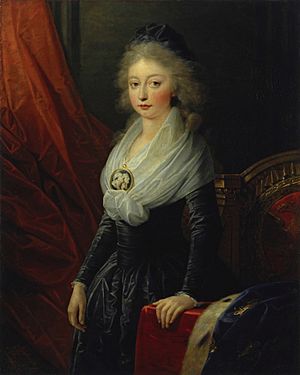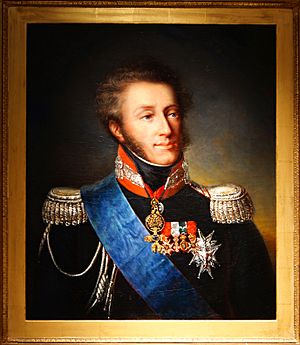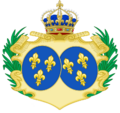Marie-Thérèse, Duchess of Angoulême facts for kids
Quick facts for kids Marie-Thérèse |
|||||
|---|---|---|---|---|---|
| Dauphine of France Duchess of Angoulême Madame Royale |
|||||
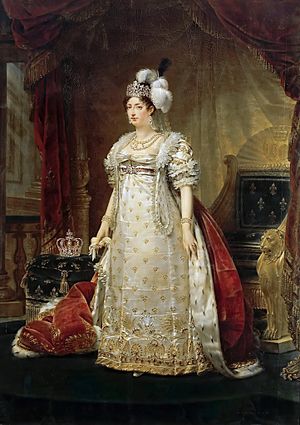
Portrait by Antoine-Jean Gros, 1816
|
|||||
| Born | 19 December 1778 Palace of Versailles, France |
||||
| Died | 19 October 1851 (aged 72) Frohsdorf Palace, Lanzenkirchen, Austrian Empire |
||||
| Burial | Kostanjevica Monastery, Nova Gorica, Slovenia | ||||
| Spouse | |||||
|
|||||
| House | Bourbon | ||||
| Father | Louis XVI of France | ||||
| Mother | Marie Antoinette | ||||
| Religion | Roman Catholicism | ||||
| Signature | |||||
| Styles of Marie-Thérèse, Duchess of Angoulême |
|
|---|---|
 |
|
| Reference style | Her Royal Highness |
| Spoken style | Your Royal Highness |
| Alternative style | Most High, Most Potent and Excellent Princess |
Marie-Thérèse Charlotte (born December 19, 1778 – died October 19, 1851) was the oldest child of King Louis XVI and Queen Marie Antoinette of France. In 1799, she married her cousin, Louis Antoine, Duke of Angoulême. This made her the Duchess of Angoulême. For a very short time in 1830, she was considered the Queen of France. Marie-Thérèse was the only one of her parents' children to live to be an adult.
She became Dauphine of France when her uncle, Charles X, became king in 1824. She was technically queen for about twenty minutes on August 2, 1830. This happened between her father-in-law signing his abdication and her husband, Louis Antoine, also signing his.
Contents
Marie-Thérèse's Early Life (1778–1789)

Marie-Thérèse Charlotte was born at the Palace of Versailles on December 19, 1778. She was the first child of King Louis XVI and Queen Marie Antoinette. As the king's daughter, she was called a fille de France. Because she was the eldest daughter, she was also known as Madame Royale.
Her mother, Marie Antoinette, almost suffocated during the birth. The room was very crowded and had no fresh air. After this difficult experience, King Louis XVI decided that future royal births would be private. Only close family and a few trusted people could be there.
Marie-Thérèse was baptized on the day she was born. She was named after her grandmother, Empress Maria Theresa of Austria. Her second name, Charlotte, honored her mother's favorite sister, Maria Carolina of Austria.
Her first governess was Princess Victoire of Rohan-Guéméné. Later, Yolande de Polastron, Duchesse de Polignac, a friend of the queen, took over. The actual daily care came from sub-governesses like Baroness Marie Angélique de Mackau. Her father, Louis XVI, was loving and liked to spoil her. Her mother, however, was stricter.
Marie Antoinette wanted her daughter to be kind and not proud. She often invited children from less wealthy families to eat with Marie-Thérèse. She also encouraged Marie-Thérèse to give her toys to the poor. The queen wanted her daughter to understand the struggles of others.
Marie-Thérèse later had two brothers and a sister. They were Louis Joseph (born 1781), Louis-Charles (born 1785), and Sophie Hélène Béatrix (born 1786). She was closest to Louis Joseph, and after he died, to Louis Charles. As a young girl, Marie-Thérèse was seen as very pretty. She had beautiful blue eyes, like her mother and grandmother. She was the only one of her parents' four children to live past the age of 10.
Life During the French Revolution (1789–1795)
As Marie-Thérèse grew up, the French Revolution was getting closer. People were unhappy, and France had a huge debt. This led to strong feelings against the king and queen. By 1789, France was heading for revolution. This was due to the country's support for the American Revolution and high food prices caused by drought. People also spread rumors and lies about Queen Marie Antoinette, making her very unpopular.
The attacks on the queen became worse, and the monarchy's popularity dropped. Inside the court at Versailles, some people were jealous or disliked Marie Antoinette because she was foreign. This led to pamphlets being printed that accused her of wasting the country's money. These pamphlets greatly harmed the monarchy and helped cause the revolution.
Despite the growing political problems, Marie-Thérèse faced personal sadness. Her younger sister, Sophie, died in 1787. Two years later, her brother Louis Joseph, the dauphin, died from tuberculosis on June 4, 1789. This was just one day after the Estates-General meeting began.
Moving to the Tuileries Palace
When the Bastille prison was attacked by an angry crowd on July 14, 1789, the situation became very serious. Marie-Thérèse, then 10 years old, saw her life change. Several members of the royal household were sent away for their safety. Her uncle, the Comte d'Artois, and the Duchesse de Polignac, her governess, left France.
Princess Louise-Elisabeth de Croÿ became the new governess. Her daughter, Pauline, became a lifelong friend of Marie-Thérèse.
On October 5, a large group of women from Paris marched to Versailles. They wanted food and political changes. Early on October 6, the palace was invaded. The royal family had to hide in the king's apartment. The crowd then demanded that the king and his family move to the Tuileries Palace in Paris.
As the political situation worsened, Louis XVI and Marie Antoinette knew their lives were in danger. They tried to escape with help from Count Axel von Fersen. The plan was to flee to Montmédy, a royalist stronghold. But their attempted escape was stopped in Varennes. The family was then brought back to Paris.
Imprisonment in the Temple Tower
On August 10, 1792, the royal family took refuge in the Legislative Assembly. Louis XVI was removed from power, though the monarchy was not officially ended until September 21. On August 13, the entire family was imprisoned in the Temple Tower. This was part of an old medieval fortress. On January 21, 1793, Louis XVI was executed by guillotine. At this time, royalists recognized Marie-Thérèse's young brother, Louis Charles, as King Louis XVII.
Almost six months later, on July 3, 1793, guards took the eight-year-old Louis Charles away. He was given to Antoine Simon, a cobbler and Temple official. Marie Antoinette, Marie-Thérèse, and Madame Élisabeth (Louis XVI's youngest sister) remained in their apartment. Marie Antoinette was taken to the Conciergerie a month later, on August 2. Marie-Thérèse was left with her aunt Élisabeth. But Élisabeth was also taken away on May 9, 1794, and executed the next day. Of all the royal prisoners in the Temple, Marie-Thérèse Charlotte was the only one to survive the Reign of Terror.
Her time in the Temple Tower was very lonely and often boring. She had only two books: The Imitation of Christ and Voyages by Jean-François de la Harpe. She read them so many times that she grew tired of them. But her requests for more books were denied by government officials. Many other requests were also refused. She often had to listen to her brother's cries when he was beaten. On May 11, Robespierre visited Marie-Thérèse, but what they talked about is not known. During her imprisonment, Marie-Thérèse was never told what happened to her family. She only knew her father had died.
In late August 1795, Marie-Thérèse finally learned what happened to her family. Her companion, Madame Renée de Chanterenne, told her. When she heard about each of their fates, Marie-Thérèse was very upset. She cried loudly from sadness and grief.
Only after the Terror ended was Marie-Thérèse allowed to leave France. She was freed on December 18, 1795, the day before her seventeenth birthday. She was exchanged for important French prisoners. She was then taken to Vienna, the capital of her cousin, the Holy Roman Emperor Francis II. Vienna was also her mother's birthplace.
Life in Exile (1795–1814)
Marie-Thérèse arrived in Vienna on the evening of January 9, 1796. This was twenty-two days after she left the Temple.
She later left Vienna and moved to Mitau, Courland (now Jelgava, Latvia). Her father's oldest surviving brother, the Comte de Provence, lived there. He was a guest of Tsar Paul I of Russia. He had declared himself King of France as Louis XVIII after Marie-Thérèse's brother died. Since he had no children, he wanted his niece to marry her cousin, Louis-Antoine. Louis-Antoine was the son of his brother, the Comte d'Artois. Marie-Thérèse agreed to the marriage.
Louis-Antoine was a shy young man who stammered. His father tried to convince Louis XVIII not to arrange the marriage. However, the wedding took place on June 10, 1799, at Jelgava Palace in modern-day Latvia. The couple did not have any children.
Living in Britain
The royal family later moved to Great Britain. They settled at Hartwell House, Buckinghamshire. Her father-in-law spent most of his time in Edinburgh, at Holyrood House.
Their long years of exile ended when Napoleon I gave up his power in 1814. This led to the first Bourbon Restoration. Louis XVIII became King of France, twenty-one years after his brother Louis XVI died.
The Bourbon Restoration (1814–1830)
Louis XVIII tried to find a balance between liberals and the Ultra-royalists, who were led by the Comte d'Artois. He also tried to stop the many men who claimed to be Marie-Thérèse's long-lost younger brother, Louis XVII. These claims caused Marie-Thérèse a lot of stress.
Marie-Thérèse found her return to France very emotional. She did not trust many French people who had supported the Republic or Napoleon. She visited the place where her brother had died. She also went to the Madeleine Cemetery where her parents were buried. The royal remains were dug up on January 18, 1815. They were reburied in Saint-Denis Basilica, the royal burial place of France, on January 21, 1815. This was the 22nd anniversary of Louis XVI's execution.
In March 1815, Napoleon returned to France. He quickly gained supporters and built an army during a period known as the Hundred Days. Louis XVIII fled France. But Marie-Thérèse, who was in Bordeaux at the time, tried to gather local troops. The troops agreed to defend her but not to start a civil war with Napoleon’s forces. Marie-Thérèse stayed in Bordeaux even though Napoleon ordered her arrest. To save Bordeaux from destruction, she finally agreed to leave. Her actions made Napoleon say she was "the only man in her family."
After Napoleon was defeated at Waterloo on June 18, 1815, the House of Bourbon was restored again. Louis XVIII returned to France.
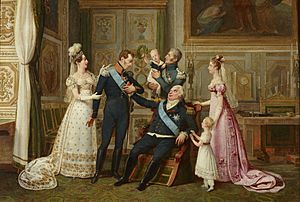
On February 13, 1820, a sad event occurred. The Comte d'Artois' younger son, the Duc de Berry, was killed. He was assassinated by Pierre Louvel, who supported Napoleon and was against the Bourbons. Soon after, the royal family was happy to learn that the Duchesse de Berry was pregnant when her husband died. On September 29, 1820, she gave birth to a son, Henri. He was called the "Miracle child." He later became a claimant to the French throne and took the title Comte de Chambord.
Marie-Thérèse Becomes Madame la Dauphine
Louis XVIII died on September 16, 1824. His younger brother, the Comte d'Artois, became king as Charles X. Marie-Thérèse's husband was now next in line to the throne. She was then called Madame la Dauphine. She is the only Dauphine whose father was a former King of France. However, people were starting to dislike the monarchy again. Charles's strong royalist views upset many working and middle-class people.
On August 2, 1830, after the three-day Revolution of July 1830, Charles X abdicated. He had gone with his family to the Château de Rambouillet. He gave up his throne to his son. His son then also gave up the throne to his nephew, the nine-year-old Duc de Bordeaux. However, even though Charles X asked him to be regent for the young king, Louis-Philippe, Duc d'Orléans accepted the crown. The Chambre des Députés named him King of the French.
On August 4, Marie-Thérèse left Rambouillet with her uncle, husband, young nephew, his mother, and his sister. They were going into exile again. On August 16, the family reached the port of Cherbourg. They boarded a ship for Britain. King Louis-Philippe had arranged their departure and journey.
Final Exile and Later Life (1830–1848)
The royal family lived at what is now 22 (then 21) Regent Terrace in Edinburgh. In 1833, the former king decided to move to Prague. He was a guest of Marie-Thérèse's cousin, Emperor Francis I of Austria. They lived in fancy apartments in Prague Castle. Later, the royal family left Prague and moved to an estate near Gorizia. This area was then Austrian but is now in Italy. Marie-Thérèse lovingly cared for her uncle during his final illness in 1836. He died of cholera.
Her husband died in 1844 and was buried next to his father. Marie-Thérèse then moved to Schloss Frohsdorf, a castle near Vienna. She spent her days walking, reading, sewing, and praying. Her nephew, the comte de Chambord, and his sister joined her there. In 1848, Louis Philippe's rule ended in a revolution. For the second time, France became a Republic.
Death and Legacy
Marie-Thérèse died of pneumonia on October 19, 1851. This was three days after the 58th anniversary of her mother's execution. She was buried next to her uncle/father-in-law, Charles X, and her husband, Louis XIX. Their graves are in the crypt of the Franciscan monastery church of Castagnavizza in Görz. This area was then in Austria, but is now Kostanjevica in the Slovenian city of Nova Gorica. Like her uncle, Marie-Thérèse remained a very religious Roman Catholic.
Later, her nephew Henri, the comte de Chambord, and his wife, the comtesse de Chambord, were also buried there. Henri's only sister, Louise, Duchess of Parma, was also laid to rest in the crypt. The famous historian Duke of Blacas was also buried there. This honored his many years of service as a minister to Louis XVIII and Charles X.
Marie-Thérèse's gravestone calls her the "Queen Dowager of France." This refers to her husband's very short time (20 minutes) as King Louis XIX of France.
The "Dark Countess" Mystery
In October 2013, a woman's grave in Hildburghausen, Thuringia, Germany, was opened. Scientists wanted to get DNA to see if she was Marie-Thérèse. This woman, named Sophie Botta, lived in a castle there from 1807 until she died in 1837. She never spoke in public and always wore a veil over her face when outside. She was with Leonardus Cornelius van der Valck, a Dutch diplomat. Together, they were known as the Dark Counts. Van der Valck called Botta 'Your Grace', and they only spoke French to each other. Some German historians thought she might be the real Marie-Thérèse. They believed Marie-Thérèse had switched places with her adoptive sister, Ernestine Lambriquet, after the revolution.
The DNA tests showed that the Dark Countess was not Marie-Thérèse. Her true identity remains a mystery. On July 28, 2014, the 'Interessenkreis Dunkelgräfin' group announced the results on German television. They proved that the Dark Countess was definitely not Marie-Thérèse.
Marie-Thérèse in Books and Movies
Marie-Thérèse has been shown in several movies, mostly about her mother's life.
Films Featuring Marie-Thérèse
- In 1934, Gladys Cooper played her (as Duchess d'Angoulême) in The Iron Duke.
- In 1938, Marilyn Knowlden played her in Marie-Antoinette.
- In 1975, Anne-Laura Meury played Marie-Thérèse in the French TV drama Marie-Antoinette.
- In 1989, Katherine Flynn played her in The French Revolution. Katherine's real mother, Jane Seymour, played Marie Antoinette in the film.
- In 2001, Daisy Bevan briefly played Marie-Thérèse in The Affair of the Necklace. Her mother, Joely Richardson, played Marie Antoinette.
- In 2006, Marie Antoinette, directed by Sofia Coppola, was released. Marie-Thérèse was played by two child actresses: Lauriane Mascaro (at age two) and Florrie Betts (at age six). Kirsten Dunst starred as her mother.
Theatre and Literature
She has also been featured in:
- All Those Who Suffered; a play from Northern Ireland about the mystery of Louis XVII.
- Madame Royale, a novel by Elena Maria Vidal, based on Marie-Thérèse's life.
- The Dark Tower, a novel by Sharon Stewart, based on The Journal of Madame Royale. This book was later re-released as The Princess in the Tower.
- The Lacemaker and the Princess (2007), a children's novel by Kimberly Brubaker Bradley.
- Faces of the Dead by Suzanne Weyn (2014) ISBN: 978-0545425315.
- Hungry Marie (2017), a manga by Ryuhei Tamura.
- When Blood Lies by C.S. Harris (2022) ISBN: 978-0-593-10269-5.
Images for kids
See also
 In Spanish: María Teresa de Francia para niños
In Spanish: María Teresa de Francia para niños


